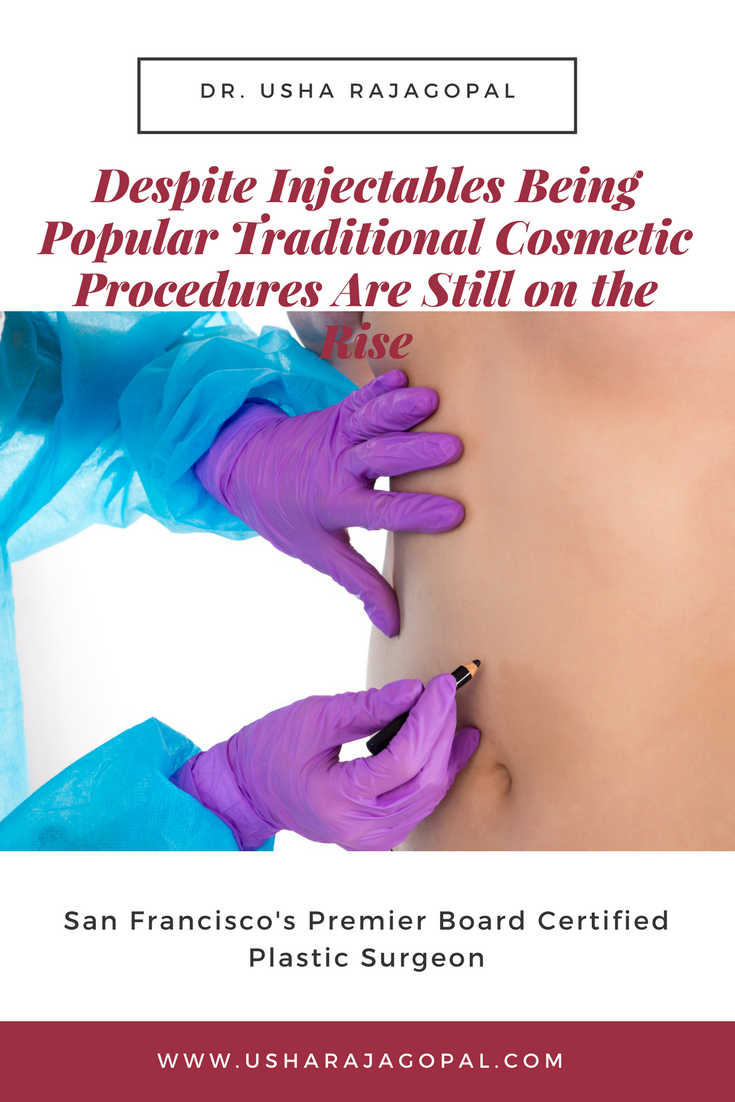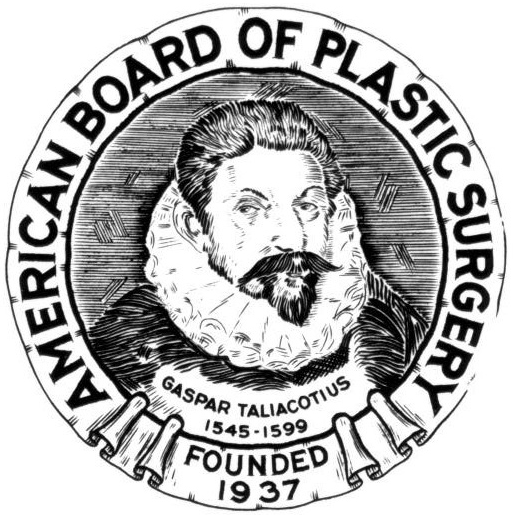Home » Uncategorized
Category Archives: Uncategorized
Despite Injectables Being Popular Traditional Cosmetic Procedures Are Still on the Rise

Dr. Usha Rajagopal has become one of the best-known plastic surgeons in the U.S. after completing her education and becoming the lead surgeon at the San Francisco Plastic Surgery and Laser Center. In her role as the lead surgeon at the center, Dr. Rajagopal has become one of the most impressive users of new technologies in the nation and believes there is much to support a change to creating individual plans to meet the needs of each patient using different techniques to achieve their goals. As a surgeon, the University of California at San Francisco graduate believes her role is to empower her patients to remain at the forefront of the drive to achieve a more settled state of mind through the use of surgical and non-surgical techniques.
Injectables are not the only option
Injectable and non-surgical options have been growing in popularity with Dr. Rajagopal reporting a rise in the number of these procedures being completed at her own office in San Francisco. Despite the spike in these numbers, the vast majority of the procedures being performed by plastic surgeons in 2017 and 2018 remain surgical by nature with the magazine “Allure” reporting 77 percent of surgeons they surveyed reporting surgeries are the most prominent procedures performed. Of these procedures, the vast majority are the most commonly mentioned forms of surgery millions of people across the nation enjoy on a regular basis including breast augmentation and nose procedures; despite this rise the numbers for those seeking non-surgical procedures are also rising to provide evidence of a society already concerned with their overall appearance which is hoping to maintain a youthful appearance as more people grow to an older age.
Botox and fillers continue to be popular
In the opinion of Usha Rajagopal, the desire for more surgical and non-surgical procedures is a growing trend which includes the cost and pain factors playing a major role in the choices made by each patient working with her friendly and efficient team. Under the guidance of a trained and licensed physician, registered nurses are able to complete the use of injectables on patients who are often only in the office for less than an hour to have Botox and fillers used on their faces.
Dr. Rajagopal believes the use of injectables and non-surgical procedures such as chemical peels can be of benefit for many are looking to begin the maintenance of their skin at a younger age. The physician believes people of every gender can preserve their younger looking skin in a positive way for the future if they begin a beauty regime in their 30s including a range of non-surgical techniques which will preserve their younger looking skin texture long into their 50s and beyond.
Older people look to expand their use of surgical and non-surgical techniques
There has been a major rise in the number of cosmetic procedures being completed for those classed as baby boomers who are aged from 63 and above with increasing numbers of older people looking to maintain their youth for the future. Over the course of the 21st-century, the number of surgical procedures taking place involving those aged 63 and above have risen more than 1,200 percent; Dr. Rajagopal agree with the view that older people are becoming an even more important part of her client list along with younger people who are looking to maintain a better skin texture for the future.
The Pittsburgh Post-Gazette reports the spike in non-surgical procedures has reached more than 90 percent for those who are aged over 63 which has been an important factor in the development of procedures such as Botox and fillers. Despite this growth in the number of non-surgical procedures, the figures back up the view of Dr. Usha Rajagopal that surgical techniques are also growing in popularity which also includes the 58 percent rise in surgical procedures seen across the U.S.
Non-surgical procedures take many different forms
Dr. Usha Rajagopal believes a healthy lifestyle and a small number of changes to life as a whole can result in many changes to the skin which can accompany the procedures of both a surgical and non-surgical kind. Dr. Usha Rajagopal believes simple lifestyle changes such as drinking more water and practicing good posture can have a positive impact on the way skin ages over the years. The San Francisco-based physician believes regular exercise is a major benefit in remaining happy, healthy, and young looking for the future.
The best option for all people who believe they would like to remain youthful and stave off the aging process is to call the San Francisco Plastic Surgery and Laser Center to ensure Dr. Usha Rajagopal and her team can work with them for a brighter future.
The Misconception That Lifting Heavy Weights And Eating Carbs Will Make You “Bulky”
The misconception that lifting heavy weights and eating carbs will make you “bulky”.
Let’s face it – we all know that health and fitness go hand in hand.
Although we understand that the path to a fit and healthy physique involves a good diet and exercise, many fail to find a long term plan that will fit their lifestyle.
First, let’s break down the term, “Diet”.
Many associate this term with restriction of food, and losing weight. For the purpose of this article, the operational definition of the term diet is as follows: the food that a person eats.
Every single person and living creature participates in some form of a diet. The difference lies in what each particular diet is meant to accomplish. Yes – some use diets to lose weight, but others may incorporate a particular diet to maintain or even gain weight.
Now that the term diet has been broken down and defined – it’s time to specifically discuss what healthy diets are and how we can incorporate them into our lifestyle. At the San Francisco Cosmetic Surgery and Laser Center, Dr. Usha Rajagopal our staff always acknowledge and approve of healthy eating habits! Specifically, Healthy diets are balanced and consist of protein, fat, and carbohydrates. Whether you’re trying to lose, maintain or gain weight – the common denominator in your diet should be: Real food.
Chemically engineered food is not part of a healthy diet. Shocker.
Although it is completely acceptable to indulge in dessert and cheat meals once in a while, the majority of a healthy diet will consist of real food.
Real food includes protein – meat, lots of it. If you have an iron deficiency, eating more meat will improve your physical and mental being drastically. You see – red blood cells carry oxygen to our muscles including our brain. If you are deprived of food that will supply oxygen to your brain, you won’t be able to think logically or function properly.
Vegans or vegetarians! I’m not here to discriminate. There are plenty of other sources of protein that can assist your diet, including supplementation, but let’s face it – there’s nothing like the real thing.
Fat: We need it. Mass media marketing has its consumers brainwashed. Body Mass Index(BMI) has everyone fooled. These may be bold statements, but everyone should be aware of all of the facts. There are good and bad fatty foods, but in general I want to get the point across that you can eat fat and be healthy. Fat helps our brains function in the morning and throughout the day(add butter to your coffee for that extra boost in the AM). Although we shouldn’t be eating buckets of fat, a little bit won’t hurt our diets! The thing consumers(me and you) should be frightened of are the products that claim to be “Fat Free”.
Now let’s break down the term “Fat Free”. Many associate this term with healthy snacks, and losing weight. For the purpose of this article, the operational definition of the term “Fat Free” is as follows: chemical shitstorm.
Earlier we learned that the healthiest foods are natural – not chemically engineered. Have you ever looked at the back of your fat-free snack? All those ingredients that are hard to pronounce have no place in your body! The best foods you can buy don’t have a label or expiration date on them, because they are real and not full of chemicals. Not only are fat-free foods bad for you – they are the worst.
Alternative options for snacks that are healthy include: nuts and berries.
A handful of nuts(almonds, pistachios, etc) are a good healthy source of fat!
If you’re craving a different sort of indulgence – you can freeze your raspberries or blackberries and eat them as a late night snack(in replacement of ice cream). Yum! This leads me to carbohydrates. Fruits are a good healthy source of carbs. We are overwhelmed with such a large selection of carbs, we must balance our diets appropriately. It is possible to get enough carbs from vegetables and fruits to sustain your diet. Carbs aren’t bad and we shouldn’t restrict them from our diets. We just have to find the right carbs to eat to keep us from getting “bulky”. Many have become aware of “gluten-free” diets, which essentially means wheat free (I’m personally totally behind). No wheat means less bloating and room for better food intake that will fuel you throughout the day.
General rule of thumb:consume more protein than carbohydrates. You will feel less bloated and more energized to take on any physically demanding activity.
Diets should be used in conjunction with a fitness regime.
Typically, people are afraid of what they don’t know. There are a good amount of people who are terrified of lifting weights, some are afraid of injuries and others are afraid of becoming “bulky”. We need to break these stereotypes.
Lifting can benefit individuals in the long run. Physically, lifting can prevent osteoporosis by building strong bones. Mentally, lifting is an outlet, a form of therapy to release stress. Implementing the right lifting program for each individual can prove to be beneficial.
Simply put, lifting heavy weights builds muscle, and muscle burns body fat(even at rest).
For those who want to lose weight, and look lean or ripped – you must lift weight and build muscle. Lifting in conjunction with the right diet(including good carbs!) will not make you bulky. Find a fitness regime that you enjoy, and a good trainer that you can work with to set individualized goals. Set behavioral goals that are easy to accomplish so you won’t set yourself up for failure. Behavioral goals include:meeting with your trainer at least three times per week. At the San Francisco Cosmetic Surgery and Laser Center, Dr.Usha Rajagopal our staff keep each other accountable to keep active and in shape! It is important to be accountable in your fitness journey, so find a buddy to work out with, record your workouts and be consistent in your training. Results will take time, and every little effort counts. Some fun ways to lift weight include, Powerlifting, Olympic Weightlifting, Bodybuilding and CrossFit. Do your research, find what fits your lifestyle and try it out!
Throw away your scale, eat a balanced diet of real food, lift weights, have fun and trust in the process!
How to Choose a Surgeon
Top 10 Qualities to look for when you go to choose a Plastic Surgeon
Have confidence when you go to choose a plastic surgeon. Here are the top ten qualities your aesthetic plastic surgeon should have:
- Board Certification
- ASAPS Membership
- Experience
- Facility Accreditation
- Hospital Privileges
- Reliable References
- Thoroughness
- Rapport
- Follow-up Care
- Reasonable Cost
- Board Certification
- A doctor’s board-certification is the best indicator of his or her training in a particular medical or surgical specialty. In the USA, look for certification by the American Board of Plastic Surgery (ABPS), the only Board recognized by the American Board of Medical Specialties (ABMS) to certify doctors in the specialty of plastic surgery. In Canada, look for certification by the Royal College of Physicians and Surgeons of Canada (RCSC). International plastic surgeons should be board certified in their country of origin and a member of ISAPS and IPRAS.
⬆ Back to top - ASAPS Membership
- ASAPS membership ensures that in addition to certification by the ABPS or RCSC, a doctor also has significant experience in cosmetic surgery. ASAPS membership is by invitation only. Plastic surgeons who are not citizens of the United States or Canada who meet the high professional and ethical standards required for ASAPS membership may become ASAPS international active members. To ensure that your doctor is a member of ASAPS, search for them with our Select a Surgeon tool.
⬆ Back to top - Experience
- Experienced aesthetic plastic surgeons generally perform a wide range of cosmetic surgeries on a regular basis. Patients should ask about the surgeon’s experience with the particular procedure being considered. If considering a “new” technique or technology, patients should inquire whether results that substantiate safety and effectiveness have been published in a peer-reviewed journal.
⬆ Back to top - Facility Accreditation
- Cosmetic surgery can safely be performed in a hospital, a surgicenter or an office-based surgical facility: Current published data show that accredited office-based facilities have a safety record comparable to that of hospital ambulatory surgery settings. However, the majority of office-based surgical facilities are not accredited. Another advantage of selecting an ASAPS member is that all ASAPS surgeons operate in accredited, state-licensed or Medicare-certified facilities.
⬆ Back to top - Hospital Privileges
- Before granting operating privileges, hospital review committees evaluate a surgeon’s training and competency for specific procedures. Wherever the surgery will be performed, be sure that the surgeon has operating privileges in an accredited hospital for the same procedure being considered.
⬆ Back to top - Reliable References
- Asking your primary care doctor for recommendations is a good place to start, and friends may offer suggestions, but the surgeon’s board-certification should always be verified independently by contacting the American Board of Plastic Surgery (www.abplsurg.org). Free referral information to board-certified plastic surgeons with significant experience in cosmetic surgery can be found using the Select a Surgeon tool.
⬆ Back to top - Thoroughness
- The consultation is an important opportunity for questions to be asked and answered. It should include a candid discussion of risks as well as benefits of the surgery. A thorough consultation also involves a review of medical history including any existing medical conditions. All these factors help the surgeon to custom-tailor the operation to best meet the needs of each patient.
⬆ Back to top - Rapport
- Even the most experienced surgeon is not the “right” surgeon for every patient. Any successful relationship depends on good communication. Patient satisfaction is enhanced when surgeon and patient candidly discuss goals, agree on realistic expectations, and plan the course of the surgical journey together.
⬆ Back to top - Follow-up Care
- Good surgical care does not end with the surgery. For most surgeries, plastic surgeons want to see the results and monitor your progress. Nonsurgical procedures usually require a consistent schedule, so you can maintain your results. You should inquire about follow-up visits and about the doctor’s policies should surgical revisions be necessary.
⬆ Back to top - Reasonable Cost
- National averages for surgeons’ fees can be found here. Keep in mind that costs may vary considerably depending on geographic region, surgeon experience and individual patient factors. Not all patients can be treated with the same technique, and the complexity and length of surgery affect cost. Patients should note that cosmetic surgery is not usually covered by insurance.
You should feel confident when you choose a plastic surgeon, both in their abilities and how comfortable you feel with them. Don’t be shy to shop around until you find exactly what you want. Only you can choose a plastic surgeon that will be best for you.

